Every six months or so, I write an internal reflection on the current state of cryptocurrencies and where they might be headed. I decided to make my latest one public in the hope that it might interest you.
The article is divided into three parts: existing successful projects, other things that have happened (or are happening), and new things I am looking forward to. Although I will try my best to support the analysis with data, there will inevitably be some personal opinions mixed in. I hope this article will arouse your interest. If the response is positive or the feedback is constructive, I will consider sharing more such thinking articles in the future.
Existing successful projects
The good news is that there are many projects that are working well and achieving significant results. Many of these projects can be called "big ideas" because they have the potential to significantly change the status quo. Their success will bring new opportunities.
For clarity, I use the term “existing successful projects” to refer to projects or trends that are demonstrating sustainable product-market fit, are scaling the crypto market, or both.
So what projects or trends are currently showing signs of success or growth? I’ve selected a (non-exhaustive) list of 10 projects that are showing clear signs of “success”:
- Stablecoins
- Bitcoin as an alternative asset
- Farcaster, an early but growing social network
- Asset Creation
- Community-created and trained AI models
- Solana
- Ethereum
- Zora
- Coinbase
- On-chain exchanges
Stablecoins
On-chain stablecoin supply has seen net inflows of approximately $25 billion so far this year. Overall inflows have been positive since November 2023. Permissionless, global access to the U.S. dollar continues to enjoy strong product-market fit.
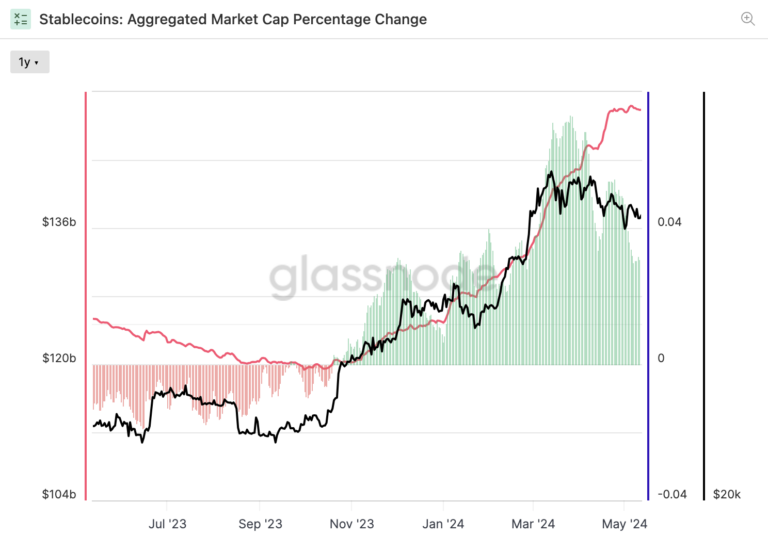
Bitcoin as an alternative asset
In January this year, nearly ten Bitcoin spot ETFs were approved. As of early June, more than $80 billion worth of funds have been deposited in Bitcoin spot ETFs. (Data from Blockwork & The Block )
Gold seems to be a good analogy for understanding institutional allocations to Bitcoin: whether or not you believe that this asset represents an inflation hedge, it is an alternative to traditional stocks and enjoys a certain degree of social consensus. One could argue that Bitcoin is better than gold because it is easier to transfer, the supply cap is known, and the asset is gaining adoption on the balance sheets of some companies and countries, and therefore could exceed the market value of gold.
In the private markets, the first quarter was marked by a slew of projects attempting to extend the utility of Bitcoin. This included (many) Bitcoin smart contract layers, on-chain lending protocols, and exploring how Bitcoin’s economic security budget can be used to help secure other chains. I suspect the fruits of these developments will likely be seen in the second half of the year.
Farcaster
Farcaster, a social network built on an open protocol, is beginning to enjoy significant growth.
The turning point came in late January with the launch of frames, small application widgets that people could share and interact with directly in the Farcaster client’s social feed.
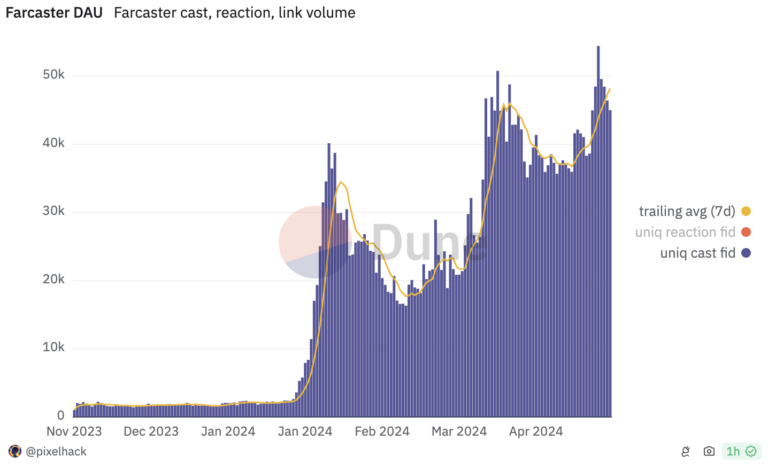
Asset Creation
The number of new token creations continues to rise. One way to track this trend is to look at the number of new tokens appearing on decentralized exchanges (DEXs). Activity is primarily driven by asset creation on Base and Solana.
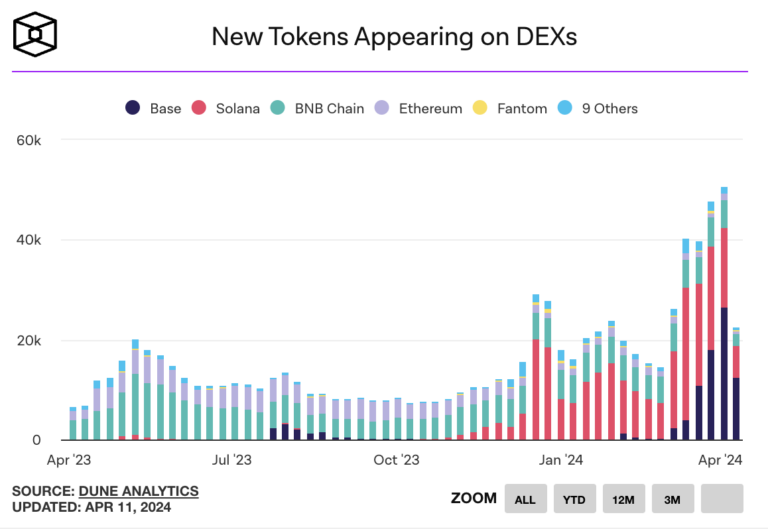
On Solana specifically, over 10,000 new tokens have been created every day over the past few weeks.
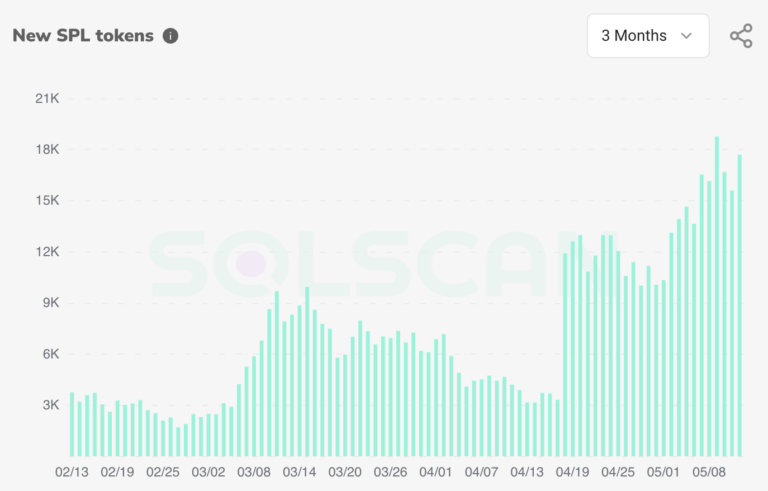
Many of these new assets are in the form of memecoins. I wouldn’t describe myself as an active participant in the memecoin space, but I do recognize a very real and active group of users who demonstrate a passion to participate.
It’s worth noting that the emergence of these new assets has led to some unexpected but productive byproducts in the broader ecosystem. For example, we’re seeing more experimentation with new tools like Solana’s token extensions. A token called $BERN innovates on token economics using Solana’s new token extensions: if someone sells their tokens, 5% of that transaction is burned (as a redistribution mechanism to remaining holders). The popularity of $BERN has served as a driving force for wallets to adopt token extension standards — standards that help enable complex payment allocations, confidential transfers, and more. Without $BERN, who knows how long token extension adoption would have taken.
Overall, my main takeaway is that asset creation seems to be a trend with a tailwind. Regardless of how you feel about these assets, owning issuance and trading are always two excellent positions in the flow of value.
Community-created and trained AI models
Clearly, we are heading towards a world where LLMs (Large Language Models) are plentiful, creation is cheap, and choice is plentiful. In such a world, where does value accumulate?
I believe that value accumulates in scarce resources. So in a world of abundant computing power, content, and tools, the question becomes: what is scarce? One answer is taste and attention. The problem is that taste and attention are fairly intangible resources. Even if we can measure them (e.g., “screen time” as a measure of attention), it’s hard to put a price on that metric.
We are starting to see the crypto track help by tightly integrating the financial track with taste- and attention-based activities. Specifically, community-created and trained AI models that have some kind of productive output — such as a good or service that can be sold or licensed (like art, movies, intellectual property, etc.) — provide the ability to reward participants. For models with subjective outputs, community participants act as tastemakers by training models based on their cultural preferences . There is a strong incentive to choose good taste: the more tasteful the output, the higher the selling price.
We are starting to see some of these projects emerge in real and effective ways. Botto is my favorite example. It is an autonomous artist where $BOTTO token holders have the ability to help train the model every week.
Botto's art is getting better and better, and the prices of Botto's works at its weekly auctions are rising. At the same time, the network of owners-participants is growing:
I think we’ll start to see more community created and trained AI models, especially as the number of known and working examples (like Botto) continues to grow.
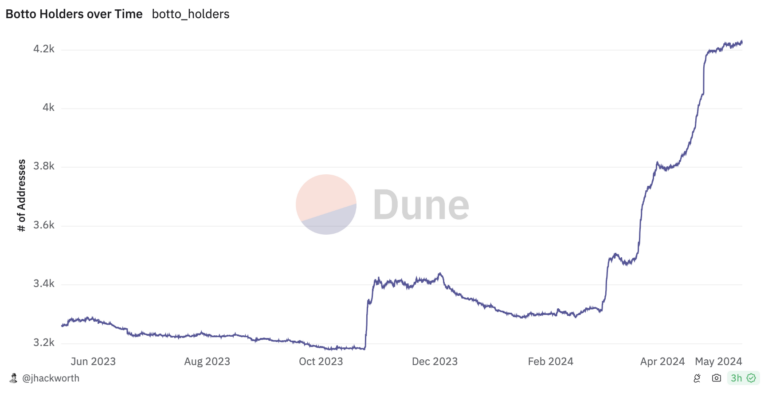
Some companies are addressing attribution from the top down, through litigation , data licensing agreements , or a combination of both. If we assume that the status quo represents less than 1% of the model output that will exist in the next five years, there is clearly room for other attempts to address attribution and assign value to contributors. Crypto rails offer a uniquely valuable solution. Crypto strengthens the economic and creative attribution equation. Importantly, it also allows anyone, anywhere to participate.
In an old blog post, Chris Dixon mused :
“There’s a famous quote: ‘The future is already here, it’s just not evenly distributed.’ An obvious follow-up question is: if the future is already here, where can I find it?”
Community created and trained models are an area where we have some small but growing projects that very much point to a much larger future.
Solana
Daily active addresses interacting with Solana are 2-3x higher than this time last year , and roughly on par with the highest activity period in the 2021 cycle. Monthly active addresses have increased 3-4x over the same time frame, reaching a new high in May 2024:

The network has also begun to generate significant fee revenue, beginning to prove the hypothesis that Solana’s low fees will be compensated by higher user activity/transaction volume.

Conclusion: Solana’s trajectory suggests that it is operating in a meaningful way and is here to stay.
Ethereum
The Ethereum ecosystem has also made significant progress. There are two ways to frame this growth: focusing on Ethereum itself, or looking at the Ethereum chain as a whole (i.e. including the Ethereum roadmap).
Ethereum itself has seen significant growth in monthly active addresses. The 30-day average has increased by about 30% YTD and is only about 10% below its 2021 peak .
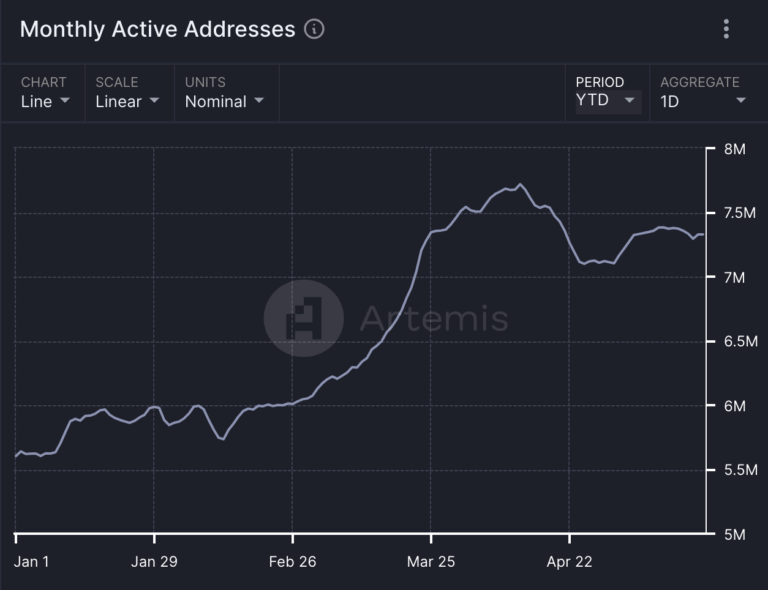
Looking at the Ethereum ecosystem as a whole also shows significant signs of growth. I aggregated the daily active addresses for the five top Ethereum chains - Ethereum, Arbitrum, Base, Optimism, and Polygon. These five were chosen because they have rich application and developer ecosystems.
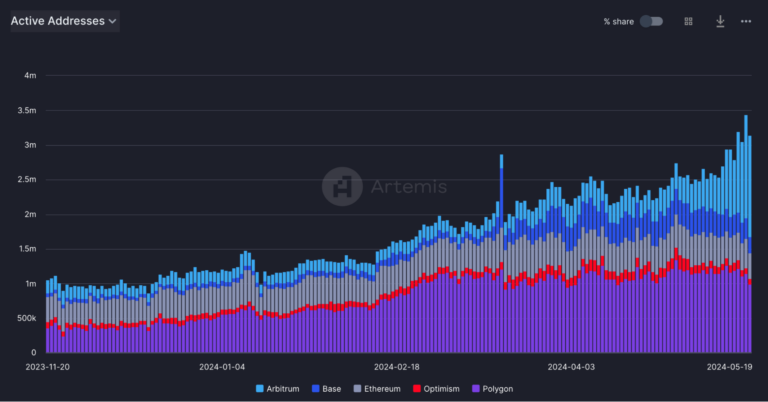
Conclusion: Ethereum has been and will continue to be one of the most important ecosystems in the crypto space.
Zora
Zora Chain (also known as Zora Network ) has been online for about a year. During this time, the network continues to find its niche. Weekly active users have increased by about 60% year-over-year, recently surpassing a new high of 250,000. The chain also enjoys a profit margin of about 34% , meaning that Zora retains a third of the ETH that users spend on transaction fees.
Zora ChainZora Chain proves the concept that applications with enough distribution capabilities can begin to vertically integrate with other parts of the stack (such as blockspace), unlocking more attractive economics.
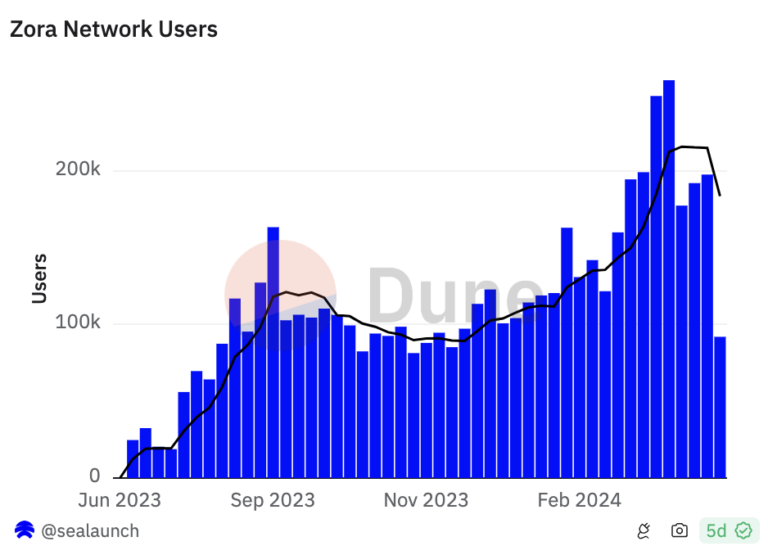
Coinbase
Coinbase also had a strong start to the year. It is listed as the custodian for 8 of the 11 Bitcoin spot ETFs. The trading business also continued to make progress - trading volume reached $157 billion, the highest value since November 2021.
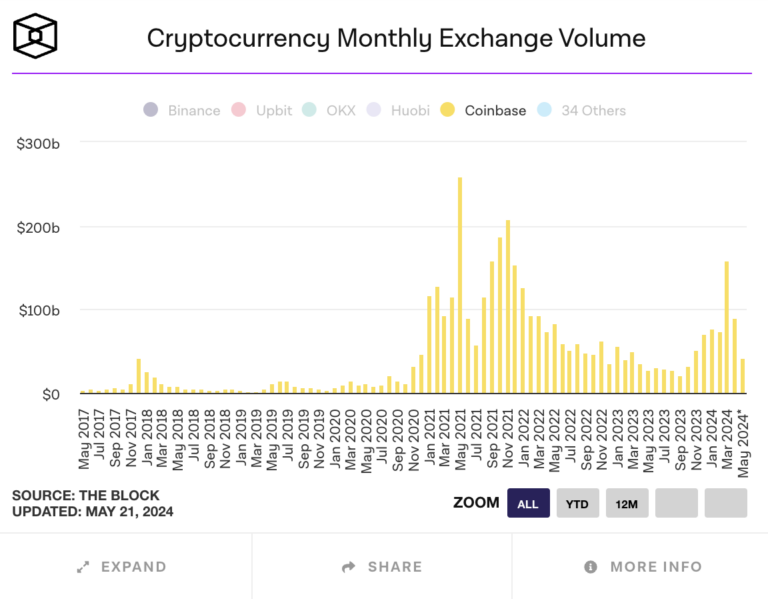
Trading fees still make up the majority of Coinbase’s revenue. In the first quarter, the platform generated more than $1 billion in revenue from trading fees (roughly two-thirds of its quarterly revenue).
But it’s also worth noting that Coinbase continues to diversify its revenue streams beyond transaction-based fees. Blockchain reward revenue and custody fee revenue both doubled from the previous year. Stablecoin revenue is approaching $200 million, with USDC’s circulating supply growth offsetting (slightly lower) interest rates. Coinbase One , Coinbase’s membership suite, has over 400,000 subscribers. Base, Coinbase’s layer-2 protocol, generates millions in on-chain fees each month .
Coinbase’s success demonstrates what (until recently) many people had only assumed: that many meaningful new business models can be built around crypto primitives.
On-chain exchanges
On the Ethereum mainchain, the number of unique users (traders) on Uniswap has roughly doubled in the past six months.
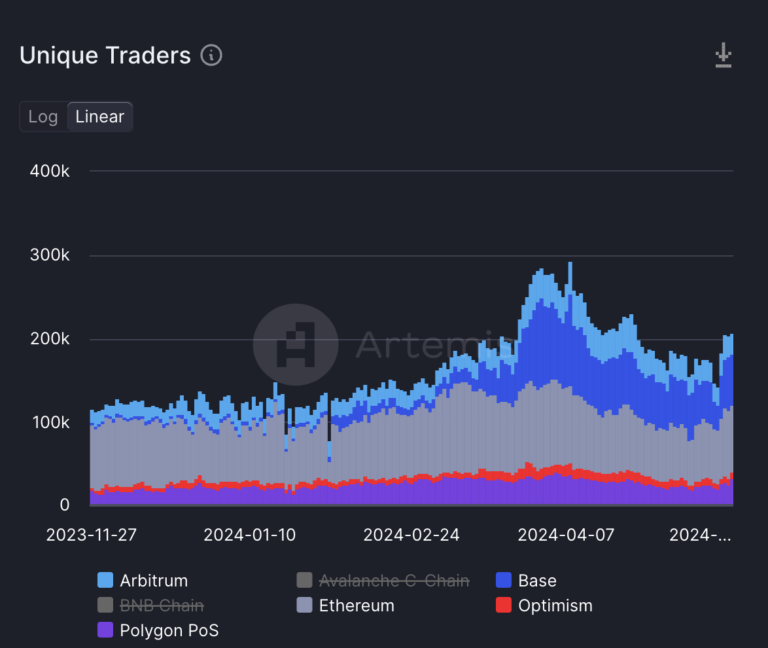
One of the definitions of a successful protocol is that successful businesses can be built on top of it. We see this happening with on-chain exchanges, exemplified by the growth in revenue Uniswap Labs has generated through its interface:
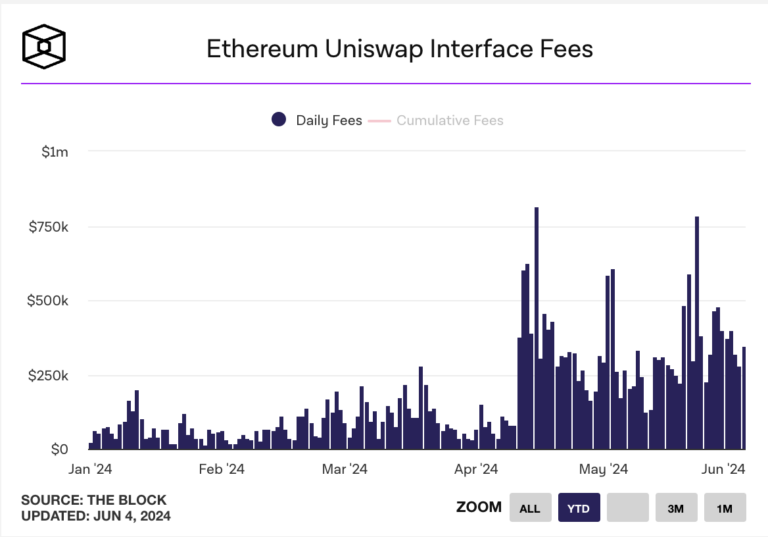
The 7-day moving average volume facilitated by Uniswap (the protocol) also recently surpassed Coinbase:
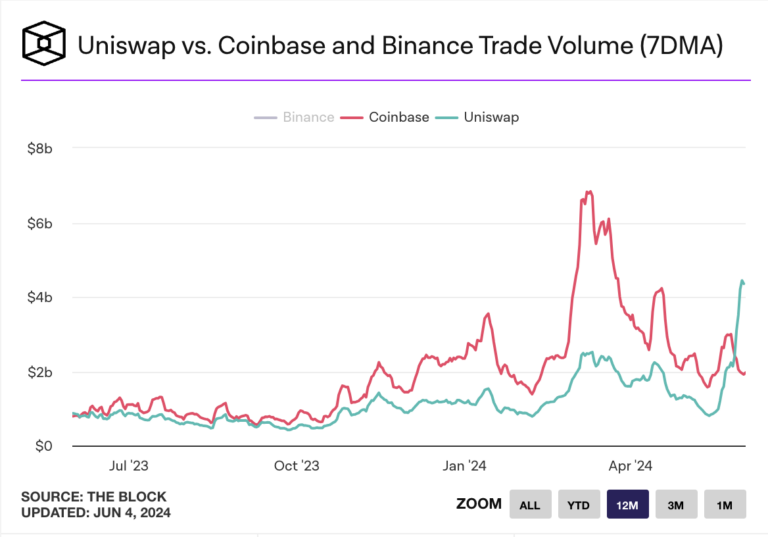
Importantly, we are seeing growth in on-chain exchanges not only on Ethereum, but also on Solana. Orca and Raydium, two leading DEXs, also showed significant growth:

It is no small matter that on-chain protocols facilitate billions (if not tens of billions) of dollars in value exchanged each month. These protocols and interfaces represent very real, revenue-generating projects. In cases where centralized institutions exist (such as interface businesses), I would like to see a portion of these profits reinvested into improving security, robustness, and user experience.
Additional Project: Blackbird
Blackbird is a loyalty and rewards program designed for the restaurant industry that uses cryptography at the bottom. When a user checks in at a restaurant connected to Blackbird, the app mints them an NFT—a digital memento of their visit and a data point for restaurants in the network to understand their customers’ dining habits. Today, Blackbird exists primarily in New York City.
The number of Blackbird user check-ins continues to grow.
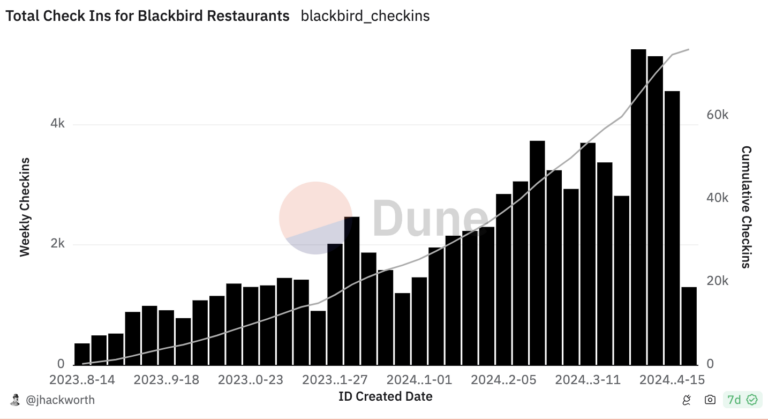
Personally, Blackbird has changed my dining habits: where before I would let my friends choose where we would eat, now I become more active in suggesting places and primarily use the Blackbird app to guide us to restaurants that might interest us.
Other things that happened
Other notable trends over the past two quarters include the rise of Social Finance (SocialFi) and the proliferation of new chains (primarily L2 and L3 in the Ethereum ecosystem). While I feel it is too early to say whether these trends are indeed "successful", it is worth noting that these trends are significantly affecting users' on-chain activities and how developers evolve their business models.
Growth of social finance applications
There are a number of financialized social (“social finance”) applications emerging. Several applications have already generated millions in fees. The two most popular applications I know of are Friendtech and FantasyTop. Clearly there are users who find these applications interesting and are willing to participate. It’s great to see new on-chain activity from users.
I’m skeptical about the sustainability of some of these business models. Speculation alone doesn’t seem enough to drive long-term success. But that’s okay. These apps may just need some tweaks to achieve more sustainable business models. Even the attention driven by speculation offers the opportunity to monetize that interest in other ways. Of course, this critical second step is the hardest.
The proliferation of new chains
We’ve also seen a number of new chains — especially L2 and L3 — launched. For these chains in the Ethereum ecosystem, the underlying technology doesn’t seem to be a significant differentiator. Instead, brand and community trump everything. Base, the L2 launched by Coinbase, is probably the poster child for a strong brand. The chain enjoys a (supposedly) growing developer ecosystem even without the direct token incentives that other chains use to attract talent.
So far, we’ve seen roughly three ways that chains attempt to differentiate:
- Underlying technologies. For example, integrated vs modular chains, or optimistic vs zero-knowledge convolutions.
- Chain economics. Canto is the first chain in recent years (that I’m aware of) to attempt to redistribute transaction fees to developers in the ecosystem. Blast and Berachain are now experimenting with various other types of revenue generation and economic distribution. It’s unclear to what extent these are sustainable — both in terms of general economic considerations and in terms of providing long-term competitive advantage.
- Brand and community. A chain’s culture and/or reputation can provide an attractive halo for developers: it might enhance the perception that the developer has more help (from the community or other developers) when building in the ecosystem, it can provide reputational cover for certain consumers (“no one is to blame for choosing a MacBook” or something like that), and/or the values espoused by the chain’s community might simply align with the developer’s own philosophies.
Mature chains have all three elements. Take the two “successful” chains I highlighted above: Ethereum and Solana. Ethereum pioneered the EVM, implemented EIP-1559 (which burns a portion of transaction fees to ETH holders as a redistribution mechanism), and cultivated a strong developer community and ethos around its technology. Solana popularized integrated blockchains, was the first chain to make low fees commercially viable, and its community was truly tested during the 2022-2023 trough.
My hypothesis is that the next wave of chain differentiation will come from external integrations. Examples might include seamless access to additional funding sources (e.g. a Coinbase account), KYC screening for wallets, or verifying that someone is human . This is a very broad design space, and one that I’m very much looking forward to exploring in depth.
Looking ahead
Looking back over the past six months, my main conclusion is that we are still mostly discussing the same things we were discussing 6-12 months ago, but with more maturity in terms of “existing successful projects.” As these projects mature, many should and will become platforms, and the byproduct of their success will create opportunities. With growth comes growing pains, and those pains create space for third-party solutions.
Projecting the growth of these major platforms can also provide a basis for thinking about the future. What I am most concerned about are new forms of distribution and new building blocks.
New distribution and better building blocks
On the distribution side, I’m excited about a few growth vectors, including: Farcaster at a larger scale, the Telegram app with more robust wallet functionality, and interfaces like the World App continuing to attract more people ( it already has 10 million users ).
There are many new and exciting building blocks. Coinbase launched a Smart Wallet that allows users to pay directly from their Coinbase accounts. Reservoir’s Relay protocol helps eliminate the user experience of bridging funds between chains, making an on-chain “one-click” checkout experience finally possible. World ID continues to grow, hoping to provide a way to authenticate between people and agents. And much more.
This may sound a little vague. I occasionally get frustrated when I read something that seems more like abstract hope than reality, so I’ll try to get past that with a concrete example of what these building blocks and new distribution channels do.
Take modern advertising, a multi-billion dollar market that touches nearly every business. I’d guess that despite decades of improvements in attribution and targeting, it’s still full of inefficiencies. Now imagine what an “ad” on Farcaster might look like:
- A company can send coupons directly to the wallets of targeted customers (since every account has an associated wallet ).
- Coupons may be based on similar products mentioned in posts created by consumers, or posts liked by users.
- Businesses can operate with confidence that data will always remain open and accessible (i.e. no need to worry about the API being shut down or the price being jacked up), which enables them to invest in optimizing the effectiveness of this distribution channel.
- The budget allocated by a business or merchant for a marketing campaign is only spent when consumers actually make a purchase and use the coupon.
Overall, open social graphs, embedded payment rails, and verifiable digital identities will be a win-win for businesses and consumers.
A mature chain for the future
Another notable conclusion to draw from the “Effective Projects” section is that there are now several credible and growing ecosystems (Ethereum, Solana, Bitcoin). These three ecosystems compete on unique points of difference, and their respective strengths create positive pressure on the other ecosystems to continuously improve. For example, Solana’s success with low fees and high throughput has driven Ethereum’s continued innovation at the base layer and L2 layer. Similarly, Ethereum has multiple clients, which may set a goal for Solana to achieve client diversification (such as its upcoming Firedancer client). Bitcoin was the first to achieve true institutional adoption, but has also begun to experiment with implementing new programmability elements (such as Ordinals , Runes , and potential OP_CAT upgrades). Overall, I would summarize that each ecosystem is constantly striving to achieve approximate feature parity with the others. Looking at the current state of each ecosystem and the positive relative characteristics exhibited by its competitors can serve as a guide for each ecosystem to try to improve.
It feels very positive. I'm a tennis fan, I'm a tennis enthusiast, so I use a broad tennis analogy. If Federer, Nadal, and Djokovic weren't competing against each other, they likely wouldn't be at the level of their sport that they are now. Each one pushed the others to elevate their game, which resulted in really great tennis. I think the same is true of what we're seeing with the different chains in cryptocurrency today. Each chain is making greater progress at a faster pace because there's pressure to be more productive. As a result, the industry as a whole is expected to see net growth.
Some new ideas
There is a lot of infrastructure and applications worth building. Some underexplored areas that I’m interested in that have potential are:
- Different forms of credentials. Credentials (certifications, attestations, etc.) are valuable resources on-chain: both timestamping issuance and the ability to verify the issuer benefit from a public ledger. An example of such a credential might be workplace verification — a receipt from an employer that someone has worked at a certain company for a certain amount of time. Within the crypto industry, I see many examples of attempts at authentication. I think the key is to identify credentials that have real economic value — like employment verification — and focus on those markets.
- Price Differentiated Assets (PDAs). These are goods that have real economic value but for which market participants’ willingness to pay varies widely. Restaurant reservations are a great example. Recently an article about an underground reservation market in NYC went viral : popular reservations were hacked by bots and resold for thousands of dollars on exclusive secondary markets. In my opinion, if one assumes that this financialization is inevitable, then making these “assets” as transparent and accessible as possible seems like a net positive for both restaurants and diners. Restaurants can more easily check the transfer history of a reservation, while more potential consumers can participate. Tokenizing reservations could even enable some kind of programmatic price capping, or revenue sharing with restaurants. This is just one example. There are many other markets where real assets have fundamental economic value but are mispriced or inefficiently priced because market access is opaque or limited.
- New forms of token distribution. There are many opportunities to fine-tune activities people are already doing through token rewards. Blackbird is the first and most well-known example: eating out was already a widespread activity, but the presence of Blackbird rewards may have changed some users' choices of where and how often they eat. This can be applied more broadly in areas where people are already spending time and money but lack consistency or loyalty in their consumption activities. In particular, I would look for categories where merchants could benefit from some kind of alliance or cooperative effect (in terms of access to greater data/insights), and where there is a large opportunity to increase customer loyalty (via nudge-style incentives ) through fine-tuned incentives.
Whether or not any of these ideas have a good chance of having a unique “why now” is up for debate. They mostly strike me as good ideas that have been around for a while but haven’t been fully explored (and therefore deserve more attempts).
in conclusion
This musing represents a lot of what I think has been happening in the cryptocurrency space recently, but importantly, not everything. Some areas it doesn’t touch on — but perhaps could (or should) — include the growth of permanent storage solutions like Arweave , the maturation of DeFi protocols into true financial platforms like Morpho , and Telegram’s impressive push for TON .







